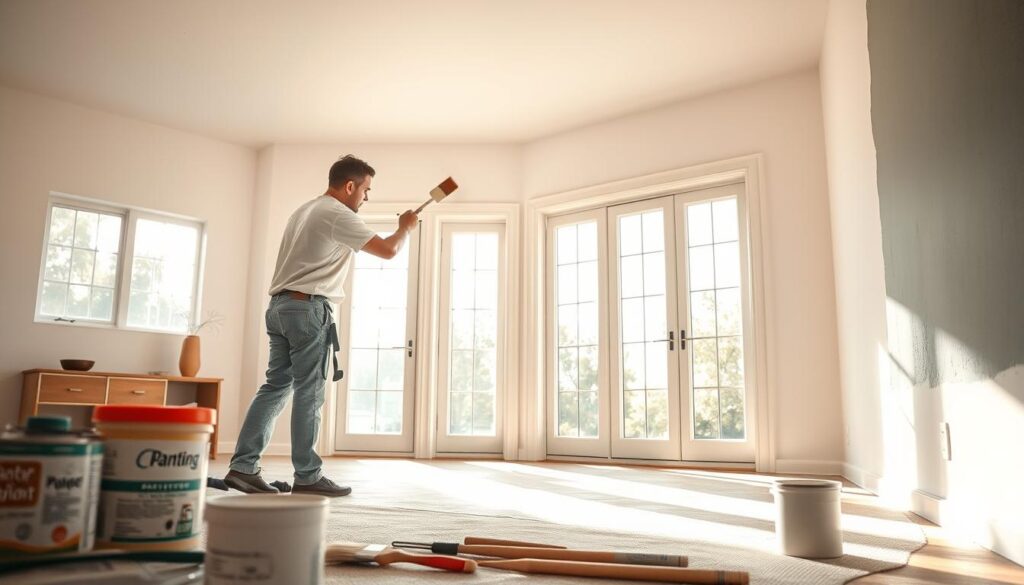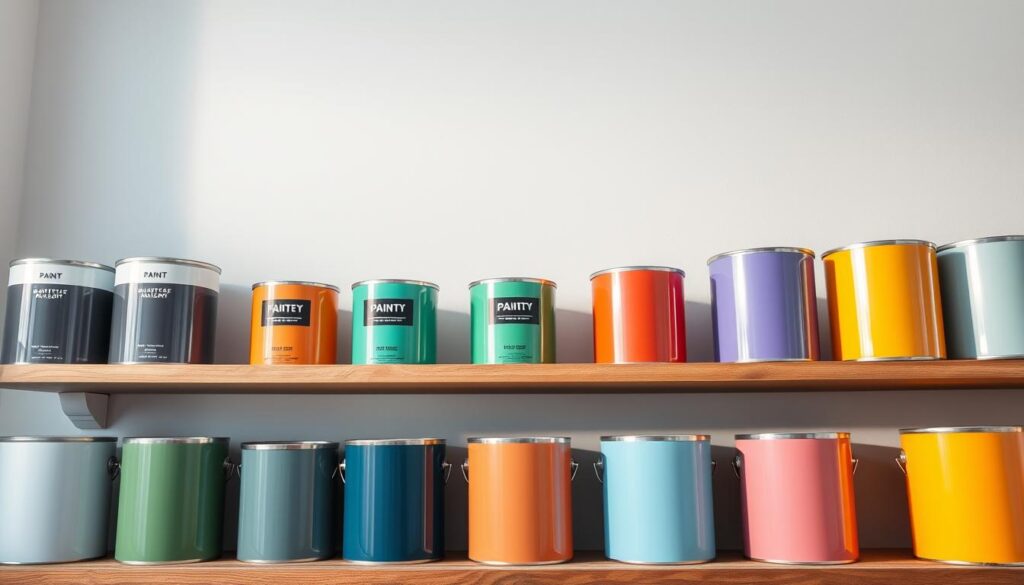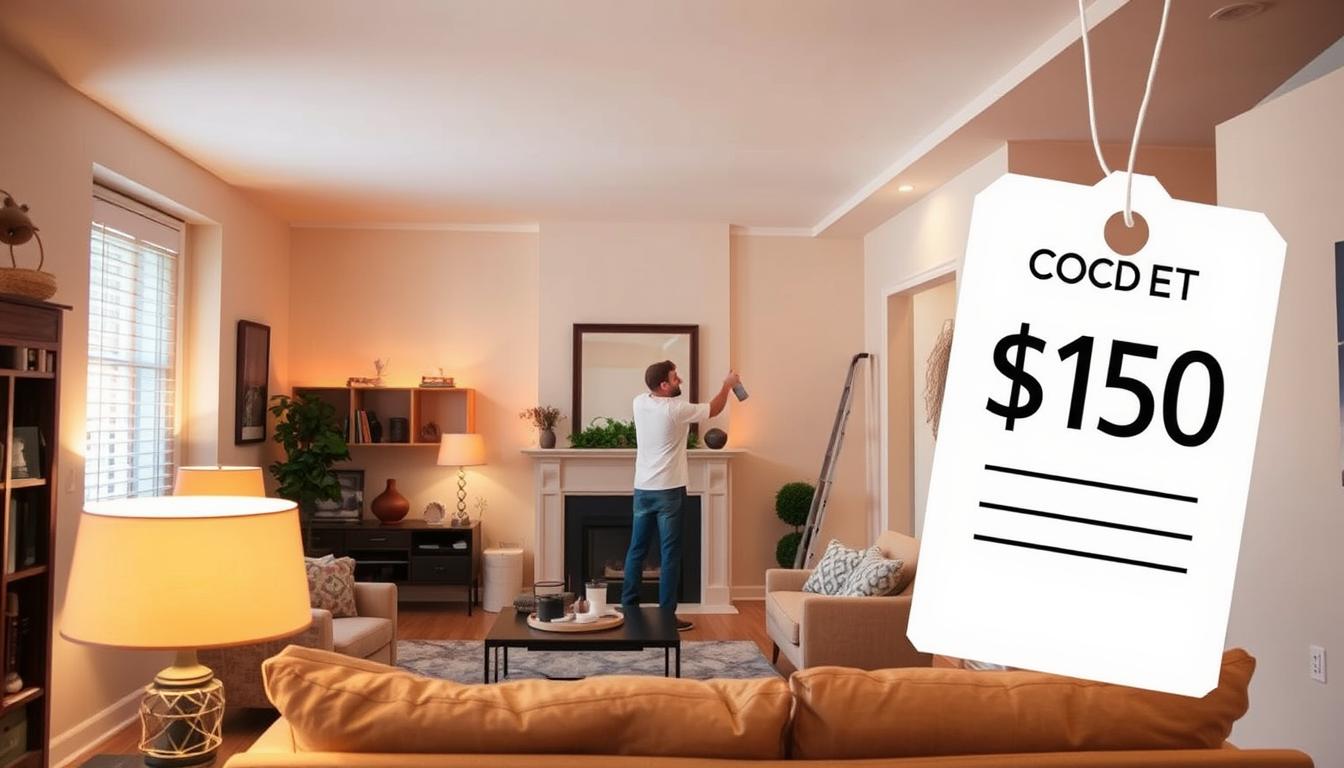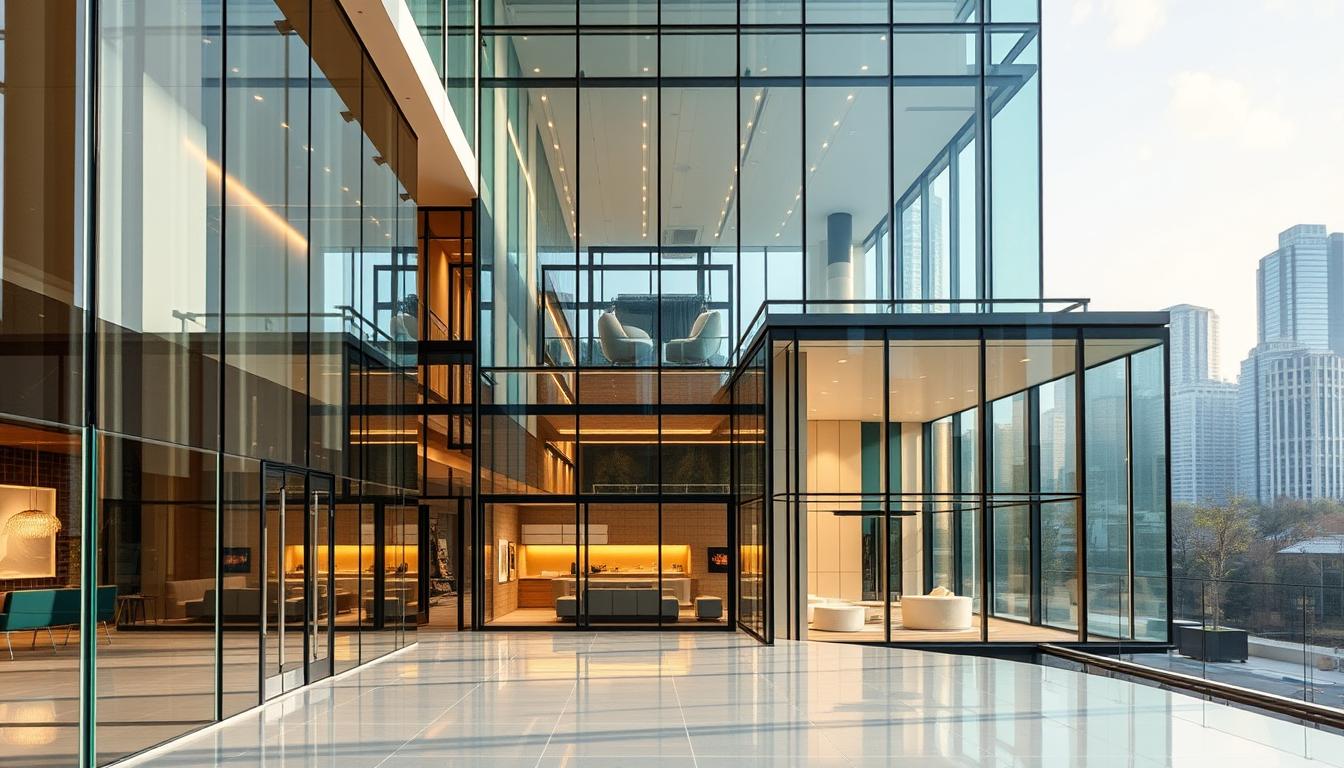Did you know a fresh coat of paint can boost your home’s value by up to 5%? This makes painting the interior a smart choice for homeowners. It’s great for those selling or just wanting a new look.
The cost to paint home interior changes based on several things. These include your home’s size, the number of rooms, and the paint type. Knowing these factors helps you plan and budget your painting project.
We’ll dive into the details of interior painting costs. Our guide will help you make smart choices for your project.
Key Takeaways
- Factors influencing the cost of painting a home’s interior include size, number of rooms, and paint type.
- Understanding these costs is essential for effective budgeting and planning.
- A fresh coat of paint can significantly increase a home’s value.
- Choosing the right paint and materials can impact the overall cost.
- Professional painting services can vary in cost based on location and expertise.
Understanding the Cost Factors in Interior Painting
Knowing what affects interior painting costs helps homeowners plan their budgets better. Several key factors influence the total cost, which we will dive into.
Size of the Area to Be Painted
The bigger the area, the more paint and work needed, which raises the cost. Here’s a look at average costs based on area size.
| Area Size (sq. ft.) | Average Cost |
|---|---|
| Less than 500 | $1,000 – $2,000 |
| 500 – 1,000 | $2,000 – $3,500 |
| 1,000 – 1,500 | $3,500 – $5,000 |
Quality of Paint Chosen
The paint quality greatly affects the cost. Better paints cost more but last longer and cover better. Let’s see the differences:
- Budget-friendly paints: Cheaper upfront but may need more coats and last less long.
- Premium paints: More expensive at first but last longer and cover better.
Labor Costs and Painter Experience
Labor costs change based on the painter’s experience, location, and job complexity. More experienced painters charge more but do better work.
Here’s a comparison to help you understand:
| Painter Experience | Average Labor Cost per Hour |
|---|---|
| Less than 2 years | $25 – $40 |
| 2 – 5 years | $40 – $60 |
| More than 5 years | $60 – $100 |
By knowing these factors, homeowners can estimate their interior painting project costs better.
Average Cost Per Square Foot for Interior Painting
Knowing the cost per square foot is key for homeowners painting their interiors. The price changes based on area size, paint quality, and labor costs.
National Averages Across the U.S.
In the U.S., painting the inside of a house costs between $2 and $6 per square foot. This price includes both the paint and the work done. The average cost is about $3.50 per square foot, based on recent data.
“The average cost for interior painting can vary significantly depending on the region, with urban areas typically costing more than rural areas.”
Here’s a table to help you understand the average costs better:
| Region | Average Cost per Square Foot |
|---|---|
| Northeast | $3.00 – $5.00 |
| South | $2.50 – $4.00 |
| Midwest | $2.00 – $3.50 |
| West | $3.50 – $6.00 |
Variations by Region
Costs for interior painting vary by region. Places like New York or California, with higher living costs, charge more. Areas with lower living costs might offer better prices.
Regional Cost Factors:
- Labor costs
- Local taxes and regulations
- Cost of materials
- Economic conditions
Factors Affecting Square Foot Pricing
Several things can change the cost per square foot for painting:
- The job’s complexity, like the number of coats or intricate trim.
- The paint’s quality and brand.
- Labor costs, which depend on the painters’ experience and local wages.
Understanding these factors helps homeowners plan and budget for painting projects.
Cost Breakdown for Different Types of Rooms
Knowing what each room in your house needs is key to getting painting costs right. Rooms differ in size, surface types, and more. This affects how much you’ll pay.
Living Rooms and Bedrooms
Painting living rooms and bedrooms is usually simple. Their costs depend on size and how many coats you need. A small room might cost $300 to $1,000 to paint.
Think about the room’s size and paint type for a better estimate. Big rooms with high ceilings or fancy trim cost more. A pro painter says, “The job’s complexity depends on the room’s condition and layout.”
Kitchens and Bathrooms
Kitchens and bathrooms are tricky because of cabinets, tile, and moisture-resistant paints. These details can increase costs. Kitchens might cost $500 to $1,500, while bathrooms are $200 to $800, due to their size.
Special coatings and handling around sinks and toilets add to labor costs. Our guide on interior painting costs explains how paint and wall condition affect the final price.
Hallways and Staircases
Hallways and staircases are harder to paint because of their complex shapes and high ceilings. Costs can range from $200 for a simple hallway to $1,000 or more for a detailed staircase.
Getting an accurate estimate depends on your hallway or staircase’s details. Height, complexity, and special needs like painting railings matter. A pro painter can give a detailed quote after seeing the area.
In summary, painting costs vary by room type, size, and specific needs. Knowing these factors helps you budget better.
Additional Services That Impact Costs
When planning to paint your home’s interior, it’s important to think about extra services. These can change your budget a lot. Paint cost is big, but other services can also raise your expenses.

Wall Preparation and Repairs
Wall prep and repairs are key services that can raise your painting cost. This includes fixing holes, cracks, or uneven areas. Proper preparation is essential for a smooth finish. It may cost more, but it makes the paint last longer.
Ceiling Painting
Ceiling painting can also affect your total cost. It’s more work than painting walls, due to designs or high ceilings. The height and accessibility of the ceiling play a role in the price.
Trim and Molding Painting
Painting trim and molding needs precision and care. It adds to your cost but gives a finished look to your interior. The cost depends on the trim’s complexity and the number of coats needed.
Knowing about these extra services and their impact on your painting cost helps with budgeting. By considering these factors, you can plan your painting project well. This way, you avoid unexpected costs and meet your expectations.
Choosing Between DIY and Hiring Professionals
Deciding to paint your home’s interior yourself or hire a pro is a big choice. It affects the process and the final look. Your budget, the job’s complexity, and your finish quality preference play a role.
Pros and Cons of DIY Painting
DIY painting can save you money on labor. But, it takes a lot of time and effort. You’ll need to buy or rent tools, prepare the area, and paint, aiming for a professional finish.
- Pros:
- Cost savings on labor
- Flexibility to work at your own pace
- Personal satisfaction of completing the project yourself
- Cons:
- Time-consuming
- Requires skill and experience for a high-quality finish
- Potential for mistakes and uneven coverage
A painting expert says, “The success of a DIY painting project heavily relies on the preparation and the quality of materials used.” (
“A good paint job starts with good preparation, and using the right materials can make all the difference in the durability and appearance of the finish.”
– John Smith, Painting Contractor)
When to Hire a Professional
Hiring a pro ensures a top-notch finish and saves you time. They have the skills, experience, and tools to do the job well and fast.
Consider hiring a pro if:
- You have a large or complex painting project
- You lack the time or physical ability to do the job yourself
- You want a high-quality, long-lasting finish
Cost Comparisons: DIY vs. Professional Services
The cost of DIY painting versus hiring a pro varies a lot. DIY saves on labor but can cost more in materials and might have errors.
| Cost Factor | DIY Painting | Professional Painting |
|---|---|---|
| Labor Costs | $0 (your time) | $2,000 – $5,000 |
| Material Costs | $500 – $1,500 | Included in the labor cost or $500 – $1,500 |
| Total Cost | $500 – $1,500 | $2,000 – $6,500 |
Choosing between DIY and hiring pros for your interior painting depends on your needs, budget, and preferences. Weighing the pros and cons will help you make a good choice.
The Impact of Paint Quality on Overall Costs
Choosing between cheap and expensive paints changes how much you spend and how long the paint lasts. When you’re painting your home’s interior, knowing how paint quality affects costs is key.
Budget-Friendly vs. High-End Paints
Paints that cost less are tempting because they’re cheaper upfront. But, they might not last as long or keep their color as well as pricier paints. More expensive paints cost more at first but offer benefits like:
- Better Coverage: Quality paints need fewer coats for a perfect finish.
- Longer Durability: They resist fading, cracking, and wear, saving you from repainting often.
- Improved Finish: They give a smoother, more even look, making your home look better.
Let’s look at the price difference between cheap and expensive paints for a typical living room.
| Paint Type | Cost per Gallon | Gallons Needed | Total Cost |
|---|---|---|---|
| Budget-Friendly | $25 | 2 | $50 |
| High-End | $40 | 1.5 | $60 |
Long-Term Benefits of Quality Paint
Choosing high-quality paint can save you money in the long run. It might cost more at first, but it lasts longer. This means you won’t need to paint as often, saving you money over time.
For example, a high-quality paint job can last 10 years or more without needing touch-ups. But, cheaper paint might need repainting every 5-7 years.
Popular Brands We Recommend
Here are some top brands known for quality:
- Benjamin Moore
- Behr Premium
- Sherwin-Williams
These brands have many products with different sheens and finishes. They meet various needs and tastes.

Preparing Your Home for Painting
Getting your home ready for painting is key to a great project. It makes painting easier and keeps your stuff safe. It also makes the paint job look better.
Moving Furniture and Protecting Floors
First, move furniture away from walls. Then, cover floors and any furniture left with drop cloths or plastic. This stops paint spills and stains from ruining your things. Try to move as much furniture as you can out of the room.
Tips for Protecting Floors:
- Use drop cloths or plastic sheets to cover the entire floor.
- Secure the coverings with tape to prevent them from shifting.
- Remove rugs and other floor coverings to prevent paint from seeping underneath.
Choosing Colors and Finishes
Picking the right colors and finishes is important. Take your time to choose colors that match your home’s style. Think about the finish you want, like flat or semi-gloss. Remember, the color you choose can change how a room feels.
Considerations for Choosing Paint:
- Consider the natural lighting in the room.
- Think about the color of your furniture and flooring.
- Test the paint samples on the walls before making a final decision.
Time Estimates for Preparation
How long it takes to prepare depends on your home’s size and how much prep you need. It can take a few hours to a couple of days. Make sure you have enough time for each step.
By following these steps and planning well, you’ll have a successful painting project. It will make your home look better and be more valuable. For home interior painting estimates and to understand the average cost to paint the interior of your house, talk to professionals. They can give you a detailed quote for your needs.
Understanding Quotes from Painters
A detailed quote from a painter is key to planning your interior painting project. It’s important to know what’s included and what’s not.
What to Look for in an Estimate
A good estimate should list labor costs, materials, and other expenses. Here are the main things to look for:
- Labor Costs: Make sure labor costs are clear, including coats and paint type.
- Materials: Check that the estimate covers paint, brushes, rollers, and more.
- Other Expenses: Look for extra costs, like moving furniture or fixing walls.
Hidden Costs to Keep in Mind
Even with a detailed estimate, hidden costs can pop up:
- Additional Coats: If the first coat doesn’t work, you might need more, which costs more.
- Wall Repairs: Hidden damage or needing to prep walls can increase costs.
- Last-Minute Changes: Changing your mind about colors or finishes can cost extra.
Questions to Ask Your Painter
To fully understand your project, ask your painter these questions:
- What’s included in the labor costs?
- Can you break down materials and their costs?
- Are there any extra costs I should know about?
- What’s the project timeline, and could there be delays?
Understanding painter quotes and hidden costs helps you plan better. This way, you can avoid unexpected expenses.
Timing Considerations for Painting Projects
Knowing when to paint your home’s interior is key to avoiding disruptions and getting a great finish. Several factors can influence when to paint, like the weather, humidity, and your family’s schedule.
Best Seasons for Interior Painting
In most places, spring and fall are the best times to paint indoors. The weather is usually mild, and humidity is stable, helping paint go on smoothly. But, the best time can change based on where you live and your home’s conditions.
If you live in a humid area all year, pick a time with good air flow. In dry areas, dust might be a problem, affecting your painting.
Potential Weather Impacts
Weather can affect your painting, even if you’re painting indoors. Extreme temperatures can slow down paint drying and lower quality. High humidity can make paint dry slowly and might cause mold or mildew.
Weather can also raise the interior house painting cost. Painting in very cold or hot weather might need special paints or extra prep work.
| Weather Condition | Impact on Painting | Precautions |
|---|---|---|
| High Humidity | Slower drying times, potential for mold/mildew | Ensure good ventilation, use a dehumidifier |
| Extreme Temperatures | Affects paint drying times and quality | Choose the right paint for the temperature, maintain a stable indoor climate |
Scheduling Around Family Life
When planning to paint, think about your family’s schedule. You’ll want to avoid disrupting areas like living rooms or bedrooms. Plan around family events, school, and work-from-home days to make it easier.
If you have pets or young kids, protect them from paint fumes and the painting process. Painting when they’re less active can be helpful.
By choosing the right time for your painting project, you can ensure a successful outcome. This will meet your expectations and stay within your budget, affecting the cost to paint home interior.
Final Thoughts on Interior Painting Costs
When we talk about painting your home’s interior, remember that budgeting and planning are key. The cost to paint your home’s inside can change a lot. This depends on the area size, paint quality, and how much labor costs.
Budgeting for Your Project
To figure out how much to paint the interior of your home, think about these points. Knowing interior home painting prices helps you plan better. This way, you can avoid surprises.
Why Paint is an Investment
Painting your home’s inside is more than just making it look good. It’s an investment in your property. A new paint job can make your home look better, increase its value, and even change how it feels.
Recap of Cost Considerations
In short, when painting your home’s inside, think about the area size, paint quality, labor costs, and extra services. By understanding these and budgeting well, you can get the look you want. And enjoy a beautifully painted home.
FAQ
How much does it typically cost to paint the interior of a home?
FAQ
How much does it typically cost to paint the interior of a home?
Painting the interior of a home can cost between and per square foot. This means the total cost can range from
FAQ
How much does it typically cost to paint the interior of a home?
Painting the interior of a home can cost between $2 and $6 per square foot. This means the total cost can range from $1,000 to $3,000 or more. The exact cost depends on the area size, paint quality, and labor costs.
What factors influence the cost of interior painting?
Several factors affect the cost. These include the area size, paint quality, and labor costs. Additional services like wall prep and trim work can also increase the cost.
Is it more cost-effective to paint the interior of my home myself or hire a professional?
DIY painting can save on labor costs but requires time and skill. Hiring a professional ensures a quality finish. It might be more cost-effective for larger or complex projects. We suggest considering your situation carefully.
How does the quality of paint affect the overall cost and longevity of the paint job?
High-quality paints cost more but last longer and need less frequent touch-ups. They are a good investment for your home. Choose a paint that fits your budget and needs.
What should I look for in an estimate from a painter?
A good estimate should detail labor, materials, and other costs. Ask about hidden costs and clarify the project scope. This ensures you understand all costs involved.
How can I prepare my home for painting to minimize costs?
Proper preparation is crucial. Move furniture, protect floors, and choose the right colors and finishes. Doing prep work yourself can save on labor costs and ensure a smooth project.
What are some additional services that can impact the overall cost of interior painting?
Services like wall prep, ceiling painting, and trim work can increase costs. Discuss these with your painter to understand their impact on your budget.
How do I choose the right paint for my interior painting project?
Consider durability, finish, and color when choosing paint. Pick a paint that fits your needs and budget. If unsure, consult a professional.
,000 to ,000 or more. The exact cost depends on the area size, paint quality, and labor costs.
What factors influence the cost of interior painting?
Several factors affect the cost. These include the area size, paint quality, and labor costs. Additional services like wall prep and trim work can also increase the cost.
Is it more cost-effective to paint the interior of my home myself or hire a professional?
DIY painting can save on labor costs but requires time and skill. Hiring a professional ensures a quality finish. It might be more cost-effective for larger or complex projects. We suggest considering your situation carefully.
How does the quality of paint affect the overall cost and longevity of the paint job?
High-quality paints cost more but last longer and need less frequent touch-ups. They are a good investment for your home. Choose a paint that fits your budget and needs.
What should I look for in an estimate from a painter?
A good estimate should detail labor, materials, and other costs. Ask about hidden costs and clarify the project scope. This ensures you understand all costs involved.
How can I prepare my home for painting to minimize costs?
Proper preparation is crucial. Move furniture, protect floors, and choose the right colors and finishes. Doing prep work yourself can save on labor costs and ensure a smooth project.
What are some additional services that can impact the overall cost of interior painting?
Services like wall prep, ceiling painting, and trim work can increase costs. Discuss these with your painter to understand their impact on your budget.
How do I choose the right paint for my interior painting project?
Consider durability, finish, and color when choosing paint. Pick a paint that fits your needs and budget. If unsure, consult a professional.


